
This article was originally published by E-International Relations on 18 November 2016.
How are some discourses more powerful than others? Why do some kinds of discourses resonate more widely than others? One need only look around at recent politics in the US and the UK, for example, to see the crucial importance of these questions. With the British public recently voting for “Brexit,” and considerable numbers of Americans reacting favorably to Donald Trump, it is imperative that International Relations (IR) scholars develop frameworks that are able to grapple with the complex politics of language, affect/emotion, and subjectivity. As the public debate surrounding “Brexit” often revolved around contestations over British national identity, and Trump’s heated rhetoric taps into strands of American nationalism, these and other contemporary debates often hinge on the processes through which collective subjects – the collective “us” – are produced through eliciting particular kinds of emotional responses. People become affectively attached and invested in the images of the national “we” that are presented to them.
Who we are – our identities as subjects – is intimately bound to the power of language. Although the study of identity and discourse has been a part of IR for some time (Campbell 1998; Hansen 2006), their relationship to emotional factors such as desire has largely been downplayed. This is key because desire is the basic dynamic driving the social construction process in general and the social construction of subjectivity in particular. In my book, The Politics of Subjectivity in American Foreign Policy Discourses, I develop a framework that analyzes how these factors interweave to produce political subjects – the collective us. Consequently, these factors underpin the power and effectiveness of political language. In doing so, the framework takes a useful step forward in IR theory because it helps to analytically pinpoint why certain kinds of narratives are more likely sources of emotional investment – and therefore more likely to be politically efficacious – than others. Consequently, the framework unpacks the key elements that sustain political notions that are taken to be “common sense.” That is, the framework highlights the emotional investments of desire in the constructs of identity that narratives of political “common sense” often offer.




